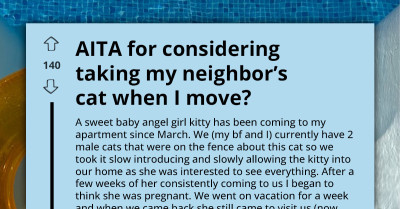Redditor Wants To Give Away Their Cat For Being Too Clingy
It's always tough to make a big move, especially when you're bringing your furry family members along. In the case of one Reddit user, things have taken a turn for the worse since moving across the country.
Their male cat got out and hasn't been seen since, leaving the other cat feeling lost and alone. OP describes the cat's behavior as concerning, saying that all she does is meow and follow them around. She has become obsessed with food and will go to great lengths to get her paws on it, including breaking into the pantry and eating until she makes herself sick.
OP has been trying to mitigate some of this behavior by feeding her wet food in a slow feeder, but the cat still tries to steal food whenever she gets the chance. It's not just food that's the issue, however.
They were hoping that the cat would bond with their dogs, but instead, she just swats at them when they try to play. OP's partner has tried playing with her, but the cat just avoids him because all she wants is to be with her human.
OP is at a loss as to what to do, as they work all the time, and their partner is in school. They're considering giving the cat away to a coworker who is looking for a second cat to be a companion to their existing one.
As pet owners, it can be heartbreaking to see our animals struggle, especially when we don't know how to help them. It's important to remember that our pets rely on us to provide them with a safe and comfortable environment.
When they're not thriving, it's up to us to find solutions, whether that means making changes at home, seeking medical attention, or reaching out to professionals for help. It's a difficult decision, which is why OP shared this story on Reddit and sought advice from other Redditors, which you can read below.
It's clear that OP loves their cat, but she's not happy anymore with her family, which is why OP is considering rehoming.

Ever since their other cat got out, the cat in question has been clingy and has started looking for attention from the minute OP walks through the door.

The cat has also had a problem with eating since she would break into the pantry at any given time and eat everything she could find.

Understanding Clinginess in Pets
The clinginess exhibited by the cat in this scenario may be a manifestation of attachment behavior, which is well-documented in both animal and human psychology. According to attachment theory, originally developed by John Bowlby, animals, like humans, form bonds that can significantly influence their behavior and emotional well-being. Research published in the journal Applied Animal Behaviour Science shows that pets often experience separation anxiety when they lose a companion, which can lead to clinginess as a coping mechanism.
In this case, the loss of the other cat could be triggering feelings of abandonment in the remaining cat, prompting her to seek constant reassurance from her owner. A study by Dr. K. A. H. K. McMillan emphasizes that such behaviors are not merely annoying but signal distress that requires attention and understanding from pet owners.
Understanding the psychological principles at play can help owners navigate their pets' emotional challenges more effectively. For instance, the concept of operant conditioning, identified by B.F. Skinner, suggests that behaviors followed by positive outcomes are likely to be repeated. By rewarding the cat for independent play or calm behavior, owners can gradually encourage more self-sufficient habits.
Moreover, recognizing signs of stress or anxiety in pets is crucial. A research article published in the journal Veterinary Clinics of North America emphasizes the importance of early intervention and behavioral modification techniques in reducing anxiety-related behaviors. Understanding these principles not only fosters a healthier environment for the pet but also enhances the owner's ability to interpret and respond to their cat's needs more effectively.
Understanding Clinginess in Pets
Clinginess in pets can stem from various behavioral and emotional factors. Cats, for instance, may seek attention due to anxiety or a desire for companionship, which can significantly influence their owners' experiences.
Research in animal behavior suggests that pets often exhibit clingy behavior when they feel insecure or are adjusting to changes in their environment.
The cat won't play with any of the dogs or OP's partner.

The only solution they could think of was to rehome the cat.

After reading the comments, OP decided not to rehome the cat and instead seek professional help.

Behavioral psychologists suggest that a cat's obsessive behavior around food may indicate an attempt to regain control in an overwhelming situation. According to Dr. Ramani Durvasula, a clinical psychologist, "Animals, like humans, can exhibit behaviors that provide immediate comfort when they are anxious." This aligns with the idea that when pets face anxiety, they may resort to behaviors such as seeking food for immediate gratification. In this instance, the cat's fixation on food likely reflects her emotional distress. Implementing a structured feeding schedule and enhancing her environment with toys and activities can help mitigate her anxiety. As noted by Dr. Alfie Kohn, an education expert, "Environmental enrichment is crucial for the mental health of animals, providing them with stimulation that can alleviate stress."
From a psychological perspective, attachment theory can provide insights into why some pets become overly dependent on their owners. Studies indicate that pets can form strong bonds with their caregivers, mirroring human attachment behaviors.
This emotional connection can lead to clinginess, especially if the pet perceives a threat to their security.
The comments were filled with people sharing advice for OP.

The cat is clearly not happy.

A new friend for the kitty.

Practical Solutions for Emotional Well-Being
To support the cat's emotional health, pet owners can implement strategies that align with behavioral psychology principles. One effective approach is to introduce consistent routines and positive reinforcement techniques. Studies in animal behavior suggest that predictable environments can significantly reduce anxiety in pets, as they create a sense of security and comfort.
Additionally, engaging the cat in interactive play can serve as an excellent distraction and promote bonding. According to research conducted by the University of Pennsylvania, pets that receive regular, stimulating interactions are more likely to exhibit reduced anxiety and clinginess. This not only helps the pet cope with her feelings of loss but also strengthens the bond between the owner and the pet, creating a more balanced emotional atmosphere.
Exploring Solutions for Clingy Behavior
Managing clingy behavior in pets often requires a combination of behavioral interventions and environmental adjustments. Research in animal training emphasizes the importance of establishing routines and providing enriching activities to help pets feel secure and engaged.
Implementing strategies like interactive toys or scheduled playtime can alleviate feelings of anxiety and promote independence.
Depressed catto.

The decision to rehome a pet is a difficult one and should not be taken lightly. It's essential to consider all the options and make the best decision for both the animal and the family.
In this case, OP's willingness to explore other options and try to improve their cat's quality of life is a testament to their commitment to being responsible pet owners.
Additionally, gradually increasing the time a pet spends alone can help them adjust to being independent. Training techniques, such as positive reinforcement, can encourage pets to explore and engage with their environment without relying solely on their owners for comfort.
Creating a safe space within the home where pets can retreat can also be beneficial in reducing clinginess.
The Importance of Understanding Pet Needs
Understanding the underlying needs of pets is crucial for fostering healthy behaviors. Research indicates that pets thrive when their emotional and physical needs are met, leading to more balanced behaviors in the home.
Recognizing when a pet exhibits clingy behavior as a cry for help can allow owners to address their needs more effectively.
Engaging in regular activities that stimulate both the mind and body can help pets feel more satisfied and reduce clinginess. Activities such as puzzle toys, training sessions, and interactive play can provide mental stimulation, fostering a sense of independence.
Moreover, seeking advice from a veterinarian or animal behaviorist can provide tailored strategies to address specific clinginess issues.
Creating a Balanced Environment for Pets
Creating a balanced environment for pets involves understanding their behavioral patterns and emotional needs. Research in veterinary behavior emphasizes that a well-structured routine can help pets feel secure and reduce anxiety.
Establishing clear boundaries while also providing opportunities for exploration can enhance a pet's sense of security.
Encouraging positive interactions with other family members and pets can also promote socialization and reduce clinginess. Gradually introducing pets to new experiences and environments can build their confidence and independence.
Ultimately, fostering an environment where pets feel safe and engaged can lead to healthier behaviors and more harmonious relationships with their owners.
Psychological Analysis
This situation illustrates the complexities of managing clingy behavior in pets. Understanding the underlying causes of this behavior is essential for implementing effective strategies.
Encouraging structured routines and providing engaging activities can help pets feel more secure and reduce their dependency on their owners.
Analysis generated by AI
Analysis & Alternative Approaches
Research in animal behavior highlights the importance of understanding the emotional and psychological needs of pets. By addressing clinginess through structured routines and engaging activities, owners can foster a more balanced and fulfilling relationship with their pets.
As studies suggest, creating a supportive environment where pets feel secure and valued can lead to healthier behaviors and a happier home.
The emotional well-being of pets, particularly in the wake of change, is a complex interplay of attachment and behavioral responses. According to Dr. Rick Hanson, a neuropsychologist, "Understanding the emotional needs of our pets can significantly enhance the bond we share with them." By employing strategies informed by behavioral psychology, as suggested by Dr. Lisa Feldman Barrett, "Owners can create an enriching environment that promotes emotional resilience in their pets." Ultimately, as both the owner and the pet adapt to their new circumstances, the journey can lead to a deeper connection and mutual support.



